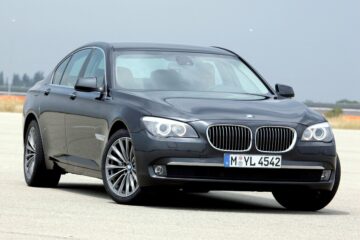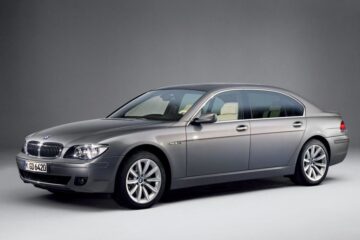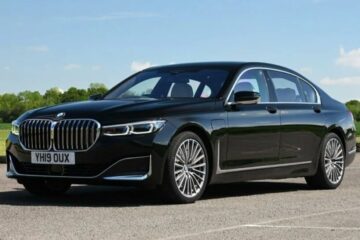One of the most important cars of the German concern BMW is the seventh series in the E23 body, which was released in 1976. This model marked the beginning of a new history of the Bavarians as a manufacturer of premium cars. And until the release of the BMW 7 E23, the brand had certain luxury cars, but it was this model that managed to squeeze the monopolist in the market – S-class from Mercedes.
The launch of the BMW 728 E23 outperformed many competitors in terms of passenger safety and comfort, as well as the equipment provided. Special indicators indicating the need to service the car were a revolutionary solution from BMW. The on-board computer and the system providing absence of brake locking were installed as an option, but in the future they began to equip the base versions of the sedan.
A wide variety of electronics, which included a climate control system, heated seats, electric window lifters and an electric mirror package, as well as a wide variety of interior upholstery options, contributed to the model’s popularity. On later modifications of the sedan began to be equipped with airbags. Depending on the date of release and performance on the car could be installed manual gearboxes for 4 or 5 speeds, as well as automatic gearboxes for 3 or 4 ranges.
1983 marked the arrival of the restyled BMW 7 Series E23, which brought a new hood extension design. Along with other changes, the turn signals and the trademark radiator grille were modernized. Changes in the interior were less significant – the dashboard was executed in an updated design, and equipped with convenient control elements.
The engines of the BMW 7-series were quite powerful – their maximum figures lay in the range from 170 to 252 horsepower, and they provided the BMW E23 good technical characteristics. All engines provided for an in-line arrangement of six cylinders. The 745i modification, which is considered top, was characterized by the installation of a supercharged motor, as well as a Jetronic fuel injection system. This allowed to provide excellent performance regardless of revolutions. Such cars provided installation of only automatic gearbox, and stood out from the general background with rich interior decoration and equipment.
This model lasted on the conveyor until 1986, then it was replaced by a new luxury sedan in the E32 body. For all the time of production, more than 285 thousand copies of this legendary car were produced.
Interior
It makes no sense to measure the upholstery of the interior by modern standards, as there have been many decades, but at that time, the quality of the materials used is considered to be quite acceptable. Already at that period wooden inserts on doors and center console were used, and also high-quality leather was used. Therefore, the interior of the BMW E23 looked quite chic.
In the photo of the BMW E23, it is noticeable that the front and rear part of the interior of the seventh series BMW is characterized by the presence of a large amount of free space. The driver is provided with a steering wheel with four spokes, which does not have any contrivances. The dashboard is characterized by rather dimensional analog gauges. The center console has placed on itself a lot of buttons for controlling the heater and the stereo. The cigarette lighter and ashtray are also located on the console.
The tunnel separating the space between the passenger and driver is also highlighted by the presence of a large amount of wood. The tunnel houses the relatively small gear selector, the handbrake and a large number of buttons for controlling various functions.
The luggage compartment of the BMW E23 coupe has a rather large useful space. When filled to the level of the windows, it can accommodate loads up to 481 liters.
Exterior
The appearance of the BMW 7 series E23 is not assessed by modern standards, since such an action does not have any meaning. But for its years, the car is characterized by a rather attractive exterior. The side is decorated with chrome trim around the windows. In front, the aggressiveness was betrayed by a branded grille, which was also framed in chrome. The side mirrors were made of the same material.
Extensions of the wheel arches were also present on the BMW E23, reviews of owners about which you can see on this page, despite the fact that it was produced a very long time ago. In those years, the appearance was quite unusual and stood out in the general automobile stream.
The representative sedan stood out also quite large dimensions of the body, which can be seen in the video about the BMW E23. The length of the model was almost five meters – 4859 millimeters, with a width of 1798 millimeters, the car received a height of 1430 millimeters. At the same time, the wheelbase was allocated 2799 millimeters.
Engines
Engines of the seventh series BMW in the E23 body has a rather large range of gasoline power units. All of these motors provided for the installation of 6 cylinders, each of which was mounted with two valves. All motors belonged to the M30 family, and were slightly modified versions from the predecessor.
The weakest in the range is considered to be the M30B25 engine, which had a displacement of 2.5 liters. This motor developed up to 150 horsepower with a maximum torque of 215 Nm. Installation of this power unit was made on the first 725th modification. Under the hood of the 728th model there was a M30B28V engine, which provided a working volume of 2.8 liters. This engine was slightly more powerful than its predecessor, and provided 170 horsepower with a peak torque of 238 Nm.
The 728i model differed by installing the M30B28 powerplant, which had the same displacement as the previous engine, but was more powerful – it provided 184 horsepower with 240 Nm of maximum torque. The M30B30V engine was installed on the 730 version. Its working volume reached almost 3 liters. The power developed by this power unit, reached 184 horsepower. At the same time, the maximum torque was 260 Nm.
There was also produced a modification BMW 733i E23 and 732i, under the hood of which you could find a motor M30B32LE, which had a working volume of 3.2 liters. The maximum power of the power unit reached 197 horsepower. Peak torque was 285 Nm. Motor 3.2 197 hp 1979 was considered quite powerful for its time.
The power unit M30B3LE had the same volume as the previous model, while its power was also not different and amounted to 197 horsepower. The maximum torque of the engine reached 280 Nm. Motors M30B35LE and M30B34M were installed on modifications 735i, as well as 735 biturbo, and differed only in working volume – in the first case it was 3453 cubic centimeters, and in the second – 3430. At the same time, the maximum power was up to 218 horsepower, with a peak torque of 310 Nm.
On the modification BMW E23 745i the same situation with motors – here provided two models M30B32LAE and M30B34MAE, having working volumes of 3120 and 3430 cubic centimeters respectively. At the same time, the power of both motors does not exceed 252 horsepower with a peak torque of 380 Nm. By modern standards, all powertrain models do not differ particularly great dynamics. Although, given the timing of their production, they were considered the fastest in their class. Most of the motors provide a power system with an injector, but it was possible to meet versions on a carburetor.
The most common and popular is the 3.4-liter power unit, which is capable of producing up to 218 horsepower with 310 Nm of maximum torque. This allowed to accelerate the sedan to the first hundred in 8 seconds and reach a maximum speed of 217 km / h. Fuel consumption of such a motor is very large – in the urban cycle, it consumed about 17 liters, and on the highway required about 8. The same motor was present in the lineup of the seventh series in the body E34.
All engines used electronic injection from the well-known Bosch company. The vast majority of power units installed on the E23 are of the atmospheric type, but after 1979 turbo versions of engines were added to the lineup. The work is carried out in pair with several types of automatic and manual gearboxes. Tuning of BMW E23 is in demand only for today, as for their time they were quite powerful.
Modifications
The first models to appear in the lineup of the seventh series in the E23 body were the BMW 728, 733i and 730, which were equipped with the Bosch fuel injection system. Until 1979, the 728 and 730 models were produced with a carburetor power system from Solex, which were replaced by the 728i modification in this year. In the future, this model became the most popular and successful in its lineup.
In the summer of 1979, the 733i was discontinued, and it was replaced by a new model – the 732i. This model was produced until 1983. It was distinguished by the fact that the engine was equipped with digital electronics. At that time, it was the first car in Europe with such functionality, thanks to which the concern gained technological leadership in the market. The 732 model was replaced by the 735i in 1979. This modification was distinguished by the installation of a gearbox with a five-speed transmission, working in tandem with a 3.5-liter power unit.
The rarest in its lineup were 725i modifications, which were to be produced only for government agencies. For the South African automobile market the production of M745i was organized. The most dynamic version 745i was assembled since 1980, and was equipped with a powerful 6-cylinder engine with 252 horsepower, which was additionally inflated with a turbine. This version was also the first production car in the world to be fitted with an electronic four-channel anti-lock system.
Equipment
BMW 7 series E23 is considered to be a car that surpassed its time, for its production years the model was considered to be quite sophisticated and high quality. The basic equipment included on-board computer, climate control system, anti-lock brakes, new mirrors and high quality leather upholstery.
Only some variants of the car were available with leather seats and wood trim. These were also supplemented with power seats, heater, mirrors and power windows with power package. Air conditioning, power sunroof, telephone and Alpine CD player were also included.
In addition, models produced from 1985 to 1986 could be equipped with a driver’s side airbag as an option. In the next generation of the 7 Series, passenger side airbags were also available.
Differences between restyling and prerestyling
1983 brought a restyling of the model, which was characterized by minor changes. The radiator grille was modernized, and the bumpers were slightly modified. As an addition, the car began to install a spoiler. Technical characteristics remained virtually unchanged, except for the addition of a Motronic 3.4 liter power unit to the lineup.
Features
BMW seventh series E23rd body was offered with a large set of six-cylinder atmospheric power units. The first models of the German sedan were equipped with gasoline motors with a carburetor power system, which in the future were replaced by engines running on the injector. The working volume of the motors ranged from 2.8 to 3.5 liters. At the same time, their maximum power was from 170 to 218 horsepower.
In 1979, the model was equipped with a 3.4 liter engine with an additional turbine, which was capable of developing 252 horsepower. Torque was transmitted to the rear axle by means of manual gearboxes with 4 or 5 speeds, as well as automatic transmissions with 3 or 4 speeds. The first generation features a fully independent suspension, which is accompanied by coil springs. Disc brake system is used on all four wheels, only the front wheels are distinguished by the presence of ventilation. Hydraulic power steering allows you to add more comfort while driving the sedan.
Spacious interior and large usable space in the luggage compartment is one of the most significant advantages of the seven in the E23rd body. To the advantages can also be attributed good equipment, as for those times, powerful engines, allowing to develop high speed, stability during driving and well thought-out ergonomics of the interior. But without shortcomings in this model did not do without. Spare parts for the original body and motor are almost impossible to find, and since the car was released quite a long time ago, frequent minor breakdowns are almost impossible to avoid.
The first generation of the seventh series was produced until 1986. After this period, a new sedan in the E32 body was introduced. During the entire time of assembly, the E23 was distributed worldwide with a circulation of more than 285 thousand cars.
Generations and configurations
Sedan 1st generation – restyling
05.1983 – 08.1986
| 728i MT | M30B28LE | 2.8L | 185 hp |
| 728i AT | M30B28LE | 2.8L | 185 hp |
| 732i MT | M30B33 | 3.2L | 197 hp |
| 732i AT | M30B33 | 3.2L | 197 hp |
| 735i MT | M30B35M | 3.4L | 218 hp |
| 735i AT | M30B35M | 3.4L | 218 hp |
| 745i MT | M30B35MAE | 3.4L | 252 hp |
| 745i AT | M30B35MAE | 3.4L | 252 hp |
Sedan 1st generation
05.1977 – 04.1983
| 728 MT | M30B28 | 2.8L | 170 hp |
| 728 AT | M30B28 | 2.8L | 170 hp |
| 728i MT | M30B28LE | 2.8L | 185 hp |
| 728i AT | M30B28LE | 2.8L | 185 hp |
| 730 MT | M30B30 | 3.0L | 184 hp |
| 730 AT | M30B30 | 3.0L | 184 hp |
| 732i MT | M30B33 | 3.2L | 197 hp |
| 733i MT | M30B33LE | 3.2L | 197 hp |
| 732i AT | M30B33 | 3.2L | 197 hp |
| 733i AT | M30B33LE | 3.2L | 197 hp |
| 745i MT | M30B32LAE | 3.2l | 252 hp |
| 745i AT | M30B32LAE | 3.2l | 252 hp |
| 735i MT | M30B35M | 3.4L | 218 hp |
| 735i AT | M30B35M | 3.4L | 218 hp |



0 Comments